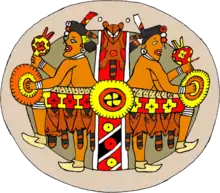Household No. 1 Site
The Household No. 1 Site is an archaeological site in Westmoreland County, Pennsylvania, United States. Located off Timms Lane in Rostraver Township, the site lies on a bluff above the Youghiogheny River.[1]: 1, 2
Household No. 1 Site (36WM61) | |
 Fields at the site | |
  | |
| Location | Off Timms Lane in Rostraver Township, Westmoreland County, Pennsylvania[1] |
|---|---|
| Coordinates | 40°10′27.7″N 79°46′44.4″W |
| Area | 8 acres (3.2 ha) |
| NRHP reference No. | 86000465[2] |
| Added to NRHP | March 20, 1986 |
Local archaeologists knew of the site in the early part of the twentieth century; the best records of the site are from amateur George Fisher, who studied the area from 1900 to 1950. More complete records were obtained after a 1980 investigation, which was part of the planning for the construction of baseball fields in the vicinity. Because archaeologists discovered a significant range of artifacts in the location, the fields were moved to allow for continued excavation. This investigation determined that the site was that of a Monongahela village.[1]: 2
Evidence of warfare dominated the findings from the Household 1 Site. Many burials were present at the site — including sixteen at the site of one house alone — and projectile points composed a much larger percentage of the total findings than did domestic tools. Furthermore, the small total number of artifacts overall shows that the site was only occupied for a short period of time, and its location on a river bluff suggests that its site was chosen for defensibility. These discoveries, like those at many other Monongahela village sites, demonstrate that the Household residents lived in a highly martial culture.[1]: 4
In 1986, the Household Site was added to the National Register of Historic Places for its archaeological significance.[2]
References
- George, Richard L. National Register of Historic Places Inventory/Nomination: Household No. 1 Site (36WM61). National Park Service, 1981-04-30.
- "National Register Information System". National Register of Historic Places. National Park Service. March 13, 2009.
